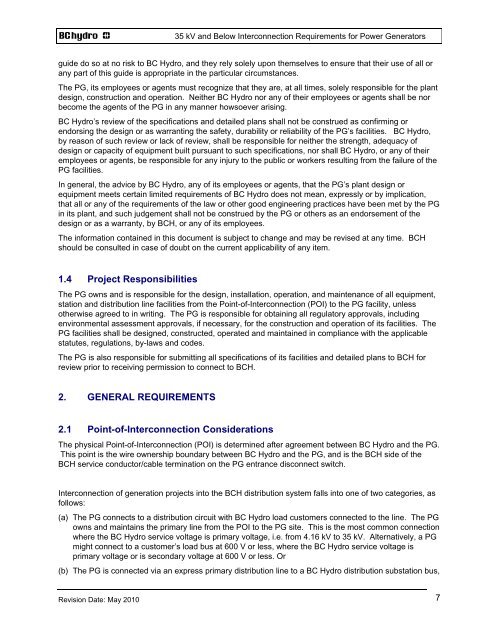35 kV and Below INTERCONNECTION REQUIREMENTS - BC Hydro
35 kV and Below INTERCONNECTION REQUIREMENTS - BC Hydro
35 kV and Below INTERCONNECTION REQUIREMENTS - BC Hydro
Create successful ePaper yourself
Turn your PDF publications into a flip-book with our unique Google optimized e-Paper software.
Revision Date: May 2010<br />
<strong>35</strong> <strong>kV</strong> <strong>and</strong> <strong>Below</strong> Interconnection Requirements for Power Generators<br />
guide do so at no risk to <strong>BC</strong> <strong>Hydro</strong>, <strong>and</strong> they rely solely upon themselves to ensure that their use of all or<br />
any part of this guide is appropriate in the particular circumstances.<br />
The PG, its employees or agents must recognize that they are, at all times, solely responsible for the plant<br />
design, construction <strong>and</strong> operation. Neither <strong>BC</strong> <strong>Hydro</strong> nor any of their employees or agents shall be nor<br />
become the agents of the PG in any manner howsoever arising.<br />
<strong>BC</strong> <strong>Hydro</strong>’s review of the specifications <strong>and</strong> detailed plans shall not be construed as confirming or<br />
endorsing the design or as warranting the safety, durability or reliability of the PG’s facilities. <strong>BC</strong> <strong>Hydro</strong>,<br />
by reason of such review or lack of review, shall be responsible for neither the strength, adequacy of<br />
design or capacity of equipment built pursuant to such specifications, nor shall <strong>BC</strong> <strong>Hydro</strong>, or any of their<br />
employees or agents, be responsible for any injury to the public or workers resulting from the failure of the<br />
PG facilities.<br />
In general, the advice by <strong>BC</strong> <strong>Hydro</strong>, any of its employees or agents, that the PG’s plant design or<br />
equipment meets certain limited requirements of <strong>BC</strong> <strong>Hydro</strong> does not mean, expressly or by implication,<br />
that all or any of the requirements of the law or other good engineering practices have been met by the PG<br />
in its plant, <strong>and</strong> such judgement shall not be construed by the PG or others as an endorsement of the<br />
design or as a warranty, by <strong>BC</strong>H, or any of its employees.<br />
The information contained in this document is subject to change <strong>and</strong> may be revised at any time. <strong>BC</strong>H<br />
should be consulted in case of doubt on the current applicability of any item.<br />
1.4 Project Responsibilities<br />
The PG owns <strong>and</strong> is responsible for the design, installation, operation, <strong>and</strong> maintenance of all equipment,<br />
station <strong>and</strong> distribution line facilities from the Point-of-Interconnection (POI) to the PG facility, unless<br />
otherwise agreed to in writing. The PG is responsible for obtaining all regulatory approvals, including<br />
environmental assessment approvals, if necessary, for the construction <strong>and</strong> operation of its facilities. The<br />
PG facilities shall be designed, constructed, operated <strong>and</strong> maintained in compliance with the applicable<br />
statutes, regulations, by-laws <strong>and</strong> codes.<br />
The PG is also responsible for submitting all specifications of its facilities <strong>and</strong> detailed plans to <strong>BC</strong>H for<br />
review prior to receiving permission to connect to <strong>BC</strong>H.<br />
2. GENERAL <strong>REQUIREMENTS</strong><br />
2.1 Point-of-Interconnection Considerations<br />
The physical Point-of-Interconnection (POI) is determined after agreement between <strong>BC</strong> <strong>Hydro</strong> <strong>and</strong> the PG.<br />
This point is the wire ownership boundary between <strong>BC</strong> <strong>Hydro</strong> <strong>and</strong> the PG, <strong>and</strong> is the <strong>BC</strong>H side of the<br />
<strong>BC</strong>H service conductor/cable termination on the PG entrance disconnect switch.<br />
Interconnection of generation projects into the <strong>BC</strong>H distribution system falls into one of two categories, as<br />
follows:<br />
(a) The PG connects to a distribution circuit with <strong>BC</strong> <strong>Hydro</strong> load customers connected to the line. The PG<br />
owns <strong>and</strong> maintains the primary line from the POI to the PG site. This is the most common connection<br />
where the <strong>BC</strong> <strong>Hydro</strong> service voltage is primary voltage, i.e. from 4.16 <strong>kV</strong> to <strong>35</strong> <strong>kV</strong>. Alternatively, a PG<br />
might connect to a customer’s load bus at 600 V or less, where the <strong>BC</strong> <strong>Hydro</strong> service voltage is<br />
primary voltage or is secondary voltage at 600 V or less. Or<br />
(b) The PG is connected via an express primary distribution line to a <strong>BC</strong> <strong>Hydro</strong> distribution substation bus,<br />
7
















